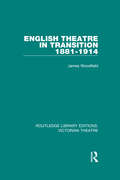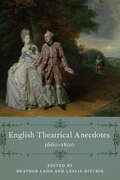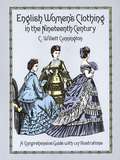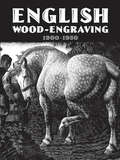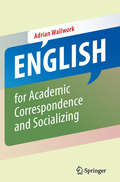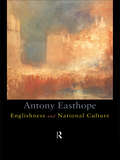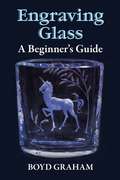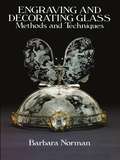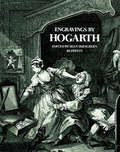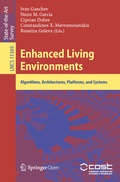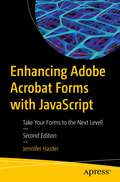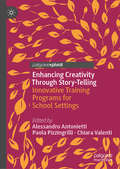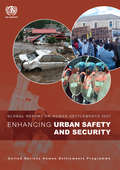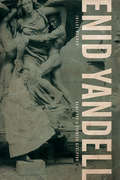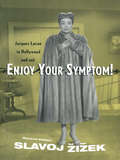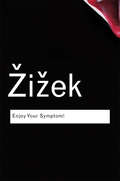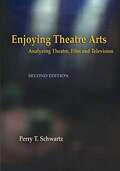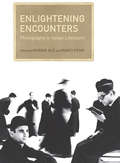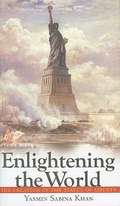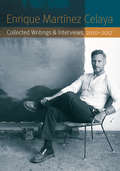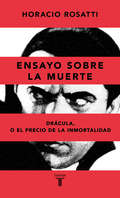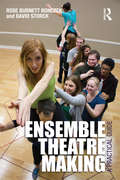- Table View
- List View
English Theatre in Transition 1881-1914 (Routledge Library Editions: Victorian Theatre #6)
by James WoodfieldOriginally published in 1984. The turn of the nineteenth and twentieth centuries was a time of considerable change in the English theatre. Victorian attitudes were shocked or shattered by the new drama of Ibsen; the major figure of George Bernard Shaw dominated the period; theatre censorship was the subject of a long and furious contest; and staging conventions changed from the spectacular stylings of Irving and Beerbohm Tree to the masking and statuesque styles of Isadora Duncan and the inner realism of Stanislavsky. This book traces the activities of the leading figures in the English theatre, notably William Archer who introduced Ibsen to this country and who became one of the main promoters of the idea of a National Theatre. Other personalities discussed include Harley Granville Barker, particularly his association with Shaw at the Court Theatre and his part in campaigns against censorship and for changes in the staging of Shakespeare, and Edward Gordon Craig, whose rebellion against the Victorian theatre took and anti-realist direction. This is a stimulating account of the background to the modern English theatre which can only increase appreciation of its standard and variety.
English Theatrical Anecdotes, 1660-1800 (Performing Celebrity)
by Fiona Ritchie Leslie Ritchie Michael Burden Danielle Bobker Chelsea Phillips Máire MacNeill Heather Ladd Nevena Martinovic Seth Wilson Elaine McGirr Amanda Weldy BoydThe essays in English Theatrical Anecdotes, 1660-1800 explore the theatrical anecdote’s role in the construction of stage fame in England’s emergent celebrity culture during the long eighteenth century, as well as the challenges of employing such anecdotes in theatre scholarship today. This collection showcases scholarship that complicates the theatrical anecdote and shows its many sides and applications beyond the expected comic punch. Discussing anecdotal narratives about theatre people as producing, maintaining, and sometimes toppling individual fame, this book crucially investigates a key mechanism of celebrity in the long eighteenth century that reaches into the nineteenth century and beyond. The anecdote erases boundaries between public and private and fictionalizing the individual in ways deeply familiar to twenty-first century celebrity culture.
English Women's Clothing in the Nineteenth Century: A Comprehensive Guide with 1,117 Illustrations
by C. Willett CunningtonThe nineteenth century was a period of continuous change for women's clothing in England. The growing prosperity of the merchant class meant an ever-larger number of women for whom "dress" was a principal function in life, while the increasing availability of lower-priced ready-made garments enabled women of moderate means to purchase the fashions of the day. In addition, the development of the railways spurred the spread of new goods, while the removal of the tax on papers in 1854 produced an abundance of fashion magazines at cheap prices, bringing news of the latest styles to the multitudes.The magnificent array of ladies' fashions that characterized the century are on display in this remarkably complete decade-by-decade overview. Drawing almost exclusively on contemporary sources — fashion magazines, newspapers, rare period photographs, memoirs, Victorian novels, periodicals, and other publications, as well as firsthand observation of actual garments — the author describes and explains the couture that evolved in response to changing social conditions, technological innovations, and cultural developments.Over 1,100 line and tone drawings and photographs depict hundreds of outfits ranging from lovely morning dresses and starkly attractive riding outfits to elegant carriage costumes, opulent evening dresses, and exquisite bridal gowns. Full-page plates also depict period millinery, footwear, underclothing, and other apparel, while three useful glossaries provide descriptions of materials, definitions of technical terms, and more.Museum curators, vintage clothes collectors, and fashion historians will find this carefully researched and well-written book an indispensable tool for dating, identifying, and authenticating vintage clothing. Not only are styles described and illustrated in detail for each year; all the small details of construction by which specimens can be dated are given wherever possible. Moreover, designers, illustrators, and fashion enthusiasts will be delighted by the superbly detailed illustrations, which painstakingly document the fashionable finery of the Victorian era.
English Wood-Engraving 1900-1950
by Thomas Balston"A wonderful look at the many styles of wood engraving from the time period 1900–1950. The illustrations are sublime, and there is a lot of variation both in theme, execution and style. I really enjoyed looking at the engravings, and the text was interesting and very readable." — Jefferson-Madison Regional Library SystemAt the turn of the twentieth century the art of wood-engraving enjoyed a flourishing revival among English artists. These works were so fundamentally different from their predecessors, in both design and technique, that they formed a new branch of the art. This volume showcases five decades' worth of magnificent wood engravings in a series of finely wrought black-and-white and color images, selected from a wide array of sources that includes lesser-known works from temporary exhibitions and limited editions.An informative history of the art precedes the illustrations, tracing the development of wood-engraving from the art form's earliest days through its decline and resurgence of popularity. A chronological presentation of striking, intricately detailed images follows, featuring the works of such noted artists as Eric Gill, Iain Macnab, Eric Ravilious, John Nash, and Clare Leighton, in addition to scores of others. Ranging from vignettes of animals and rural life to street scenes, portraits, and episodes from literature, this survey offers a magnificent overview of the vibrant era in the art of wood-engraving.
English for Academic Correspondence and Socializing
by Adrian WallworkEnglish for Academic Correspondence and Socializing is the first ever book of its kind specifically written for researchers of all disciplines whose first language is not English. With easy-to-follow rules and tips, and with authentic examples taken from real emails, referee's reports and cover letters, you will learn how to: * use strategies for understanding native speakers of English * significantly improve your listening skills * organize one-to-one meetings * feel confident at social events * manage and participate in a successful conversation * write effective emails * review other people's manuscripts - formally and informally * reply effectively and constructively to referees' reports * write cover letters to editors * use the telephone and Skype * participate in (video) conference calls * exploit standard English phrases Other books in the series: English for Presentations at International Conferences English for Writing Research Papers English for Research: Usage, Style, and Grammar English for Academic Research: Grammar Exercises English for Academic Research: Vocabulary Exercises English for Academic Research: Writing Exercises
Englishness and National Culture
by Antony EasthorpeIn this highly engaging book, Antony Easthope examines 'Englishness' as a form and a series of shared discourses. Discussing the subject of 'nation' - a growing area in literary and cultural studies - Easthope offers polemical arguments written in a lively and accessible style. Englishness and National Culture asserts a profound and unacknowledged continuity between the seventeenth century and today. It argues that contemporary journalists, historians, novelists, poets and comedians continue to speak through the voice of a long-standing empiricist tradition.
Engraven Desire: Eros, Image, and Text in the French Eighteenth Century
by Philip StewartHow do literary illustrations affect the way we read--or more subtly, what we read? Through a critical investigation of the role of engraving played in eighteenth-century French literature, Philip Stewart grapples with this question. In both its approach and its conclusions, his project marks a provocative departure from the tradition of viewing illustrations as merely pictures, rather than as texts to be interpreted themselves.Focusing on the objectification of women by the "male gaze," Stewart analyzes the varous ways in which this masculine power is simultaneously represented and veiled: the fascination with women playing "male" roles, such as soldiers; the preponderance of voyeuristic images of the naked female body; the transformation of male power into hostile forces of nature that render women helpless. Further, Stewart shows how "indecent" engravings that purported to test the limits of eighteenth-century morality often merely reinforced prevailing images of women.Addressing critical concerns about the societal enforcement of gender roles in literature along with essential questions about the function of illustration, Engraven Desire provides surprising insight into the culturally conditioned act of reading. Stewart's work, itself richly illustrated with hundreds of arresting reproductions, makes a significant contribution to our understanding of the interplay of art, literature, and society.
Engraving Glass: A Beginner's Guide
by Boyd Graham"Lucidly written and illustrated." — The Glass EngraverIf you've ever admired the exquisite beauty and craftsmanship of Steuben, Tiffany, Orrefors, or other fine engraved glass and wished you could engrave glass yourself, this book is for you. It provides step-by-step instructions for diamond-bur engraving, from making the first cut to displaying the finished work.The author, a prize-winning engraver, provides a detailed summary of tools and equipment you will need and suggestions for setting up your workshop, along with easy-to-follow practice exercises to give you a feel for working with glass and glass-engraving equipment. Mr. Graham then guides students through four complete projects, ranging from a simple tree design to a more complex flower engraving.Here are other practical features that make this book ideal for the novice: a useful discussion of design considerations and applications, review of supplemental tools and advanced techniques, expert advice on choosing glass, suggestions for the arrangement and lighting of finished pieces, and more. Over 100 helpful illustrations enhance the text.With this inexpensive book as your guide, you'll find learning the fundamentals of glass engraving far easier than you might have imagined. Simply written and easy to understand, Engraving Glass: A Beginner's Guide is your personal invitation to enjoy the challenges and satisfactions of this rewarding craft.
Engraving and Decorating Glass: Methods and Techniques
by Barbara NormanThe history of glass and glass decoration extends back at least to the ancient Egyptians, who made small vessels of dark glass and decorated them with glass threads of contrasting colors. Occasionally glass vessels were also engraved on the lapidary's wheel. Today, the ancient art and craft of decorating glass continues to flourish among artists and crafters attracted by its combination of artistic beauty and skilled craftsmanship. Unfortunately, until the publication of this book, there were few if any practical instruction guides for beginners in this exciting and deeply rewarding field.A well-known British artist and glass engraver, Barbara Norman has exhibited her glass widely and has won numerous awards. In this clear, profusely illustrated guide, she offers a comprehensive introduction to the history, materials, tools, and techniques of glass engraving and other forms of glass decoration.After introductory chapters on the development of glass, methods of glassmaking, decorating techniques and choosing glass, the author discusses various engraving techniques in detail: diamond point engraving, drill engraving, and copper-wheel engraving. Aspiring glasscrafters will also find excellent coverage of such interesting techniques as gold engraving under glass, painting glass, and applying glass to glass: mosaics, glass collage, glass fusing and glass forming. Most of the methods do not require a studio or workshop and call for relatively inexpensive materials.Ideal for the novice or moderately experienced glassworker, this well-written, easy-to-follow guide will enable glasscrafters to bring decorative beauty and artistic flair to glasses, tumblers, bowls, vases, plates -- almost any glass object. Beautiful engraved or decorated glass is perfect for personalized gift-giving or for adding a note of elegance to any home.
Engravings by Hogarth (Dover Fine Art, History of Art)
by William HogarthRake's Progress, Harlot's Progress, Ilustrations for Hudibras, Before and After, Beer Street, and Gin Lane, 96 more. Commentary by Sean Shesgreen.
Enhanced Living Environments: Algorithms, Architectures, Platforms, and Systems (Lecture Notes in Computer Science #11369)
by Ivan Ganchev Constandinos X. Mavromoustakis Rossitza Goleva Ciprian Dobre Nuno M. GarciaThis open access book was prepared as a Final Publication of the COST Action IC1303 “Algorithms, Architectures and Platforms for Enhanced Living Environments (AAPELE)”. The concept of Enhanced Living Environments (ELE) refers to the area of Ambient Assisted Living (AAL) that is more related with Information and Communication Technologies (ICT). Effective ELE solutions require appropriate ICT algorithms, architectures, platforms, and systems, having in view the advance of science and technology in this area and the development of new and innovative solutions that can provide improvements in the quality of life for people in their homes and can reduce the financial burden on the budgets of the healthcare providers.The aim of this book is to become a state-of-the-art reference, discussing progress made, as well as prompting future directions on theories, practices, standards, and strategies related to the ELE area. The book contains 12 chapters and can serve as a valuable reference for undergraduate students, post-graduate students, educators, faculty members, researchers, engineers, medical doctors, healthcare organizations, insurance companies, and research strategists working in this area.
Enhancing Adobe Acrobat Forms with JavaScript: Take Your Forms to the Next Level!
by Jennifer HarderTake your PDF forms to the next level! In this book, you’ll learn various ways to further improve your PDF forms using simple JavaScript coding. You’ll also discover how a few lines of code can speed up your workflow when working with multiple PDFs in Action Wizard. Enhancing Adobe Acrobat Forms with JavaScript covers up-to-date, real working examples that you can easily download and practice with and edit to suit your own projects. This book also shows workarounds and solutions to various form issues you might encounter. Feel empowered by it and improve your PDF documents! JavaScript has been a part of Adobe Acrobat for many versions. However, few people use its features and focus mainly on using basic form properties, never delving deeper into Acrobat’s full capabilities. While information on the web can be helpful, if you don’t know enough about how to use JavaScript in Acrobat you will be left with poor results. JavaScript can be difficult to learn, but it does not need to be scary. This book explains in simple steps for beginner to intermediate level so that you can take full advantage of Acrobat’s capabilities for your own projects. What You Will Learn • Learn simplified field notation and basic JavaScript for Acrobat • Work with buttons that can be used for navigation • Improve form navigation and printing of forms • Add various types of alerts and custom validations to improve client-entered-data • Learn the basics of how to prepare a form for e-signingWho Is This Book ForThis book is for anyone who needs to create forms for clients or websites. Students, lawyers, accountants, and human resources will be able to take their work to the next level by streamlining their workflow and utilizing advanced JavaScript features in Adobe Acrobat.
Enhancing Creativity Through Story-Telling: Innovative Training Programs for School Settings (Palgrave Studies in Creativity and Culture)
by Alessandro Antonietti Paola Pizzingrilli Chiara ValentiThis book examines the evidence-based interventions that can be used to promote creative thinking skills for children and adolescents in schools. It begins by explaining the theoretical basis of these training programmes, before presenting a coherent framework for the application of creativity theory in education. The authors describe and analyse programmes that have drawn on this framework, before offering an overview of the results of experimental studies which have validated the authors’ approach. This book provides practical guidance on how the programmes can be applied in the classroom and discusses potential future directions for research and practice for increasing children’s creativity. This book will be a valuable resource for teachers and teacher trainers, as well as to researchers in the psychology of creativity, education, and educational psychology.
Enhancing Urban Safety and Security: Global Report on Human Settlements 2007
by Un-HabitatEnhancing Urban Safety and Security addresses three major threats to the safety and security of cities: crime and violence; insecurity of tenure and forced evictions; and natural and human-made disasters. It analyses worldwide trends with respect to each of these threats, paying particular attention to their underlying causes and impacts, as well as to the good policies and best practices that have been adopted at the city, national and international levels in order to address these threats. The report adopts a human security perspective, concerned with the safety and security of people rather than of states, and highlights issues that can be addressed through appropriate urban policy, planning, design and governance.
Enid Yandell: Kentucky's Pioneer Sculptor (Topics in Kentucky History)
by Juilee DeckerThe life and work of a sculptor who pushed both aesthetic and social boundaries at the turn of the twentieth century is explored in this in-depth study.Working in the late nineteenth and early twentieth centuries, Louisville-born sculptor Enid Yandell developed a distinctly physical and masculine style that challenged the gender norms of artistic practice. An award-winning sculptor with numerous commissions, she was also an activist for women's suffrage and other political movements. This study examines Yandell's evolution from a young, Southern dilettante into an internationally acclaimed artist and public figure.Yandell found early success as one of a select group of female sculptors at the World's Columbian Exposition in Chicago in 1893. She was then commissioned to create a twenty-five foot figure of Pallas Athena for Nashville's Centennial Exposition in 1897. Yandell's command of classical subject matter was matched by her abilities with large-scale, figurative works such as the Daniel Boone statue in Cherokee Park, Louisville.Part of the art worlds of New York and Paris, Yandell associated with luminary sculptors like Frederick MacMonnies and Auguste Rodin. She became one of the first female members of the National Sculpture Society in 1898. This authoritative study explores the many ways in which Yandell was a pioneer.
Enjoy Your Symptom!: Jacques Lacan in Hollywood and Out
by Slavoj ŽižekSlavoj Zizek, dubbed by the Village Voice "the giant of Ljubljana," is back with a new edition of his seriously entertaining book on film, psychoanalysis (and life). His inimitable blend of philosophical and social theory, Lacanian analysis, and outrageous humor are made to show how Hollywood movies can explain psychoanalysis-and vice versa using films such as Marnie and The Man Who Knew Too Much.
Enjoy Your Symptom!: Jacques Lacan in Hollywood and Out (Routledge Classics Ser.)
by Slavoj ZizekThe title is just the first of many startling asides, observations and insights that fill this guide to Hollywood on the Lacanian psychoanalyst’s couch. Zizek introduces the ideas of Jacques Lacan through the medium of American film, taking his examples from over 100 years of cinema, from Charlie Chaplin to The Matrix and referencing along the way such figures as Lenin and Hegel, Michel Foucault and Jesus Christ. Enjoy Your Symptom! is a thrilling guide to cinema and psychoanalysis from a thinker who is perhaps the last standing giant of cultural theory in the twenty-first century.
Enjoy the Play!
by Robert Cohen Lorna CohenThis textbook is used at colleges around the world in Intro to Drama courses.
Enjoying Theatre Arts: Analyzing Theatre, Film and Television
by Perry T. SchwartzEnjoying Theatre Arts uses examples from Theatre, Film and Television to develop the unique analysis system detailed in this book. The text is designed as an introduction for students of the theatre arts as well as the general audience member. Contents Part One - The Theory And Analysis Art in Theatre Arts Aristotle's Six Elements of Drama Genre Based Narrative Structure Analysis Part Two - The Artistic Side Criticism The Writer The Director The Actor The Designers Part Three - The Business Side The Producer Film, Theatre, Television Business Structure The Artist/Craftsman and the Business.
Enlightening Encounters
by Giorgia Alu Nancy PedriEnlightening Encounters traces the impact of photography on Italian literature from the medium's invention in 1839 to the present day. Investigating the ways in which Italian literature has responded to photographic practice and aesthetics, the contributors use a wide range of theoretical perspectives to examine a variety of canonical and non-canonical authors and a broad selection of literary genres, including fiction, autobiography, photo-texts, and migration literature. The first collection in English to focus on photography's reciprocal relationship to Italian literature, Enlightening Encounters represents an important resource for a number of fields, including Italian studies, literary studies, visual studies, and cultural studies.
Enlightening the World: The Creation of the Statue of Liberty
by Yasmin Sabina KhanThe Statue of Liberty has been a symbol of US democratic ideals since 1886. Based on extensive research including travels to France where Liberty Enlightening the World was created, an independent scholar chronicles the story behind its conception, construction, and gifting to the US in the wake of the Civil War. Khan showcases sculptor Auguste Bertholdi, engineer Gustave Eiffel, poet Emma Lazarus, and fundraiser/publisher Joseph Pulitzer, among the many individuals involved. The book features new details about Liberty's design and b&w images. Annotation ©2010 Book News, Inc. , Portland, OR (booknews. com)
Ennis
by Ellis County Czech Heritage Society Laurie J. Wilson Ennis Heritage Society Peggy Holland RankinIn 1871, the Houston and Texas Central Railroad reached what would soon become Ennis, Texas. A year later, the city was officially established and named for Cornelius Ennis, a Houston and Texas Central Railroad tycoon. It became home to many, including a number of Civil War veterans. Czech immigrants also made Ennis their home, adding their rich cultural heritage to this growing city. In its "Wild West" days, there were as many as 13 saloons in the city, and it became a popular train stop for as many as 10 passenger trains a day. A thriving cotton industry brought thousands to the downtown district on Trade Days. Family, tradition, and a strong sense of community have always been the foundation from which Ennis has prospered. This remains evident with yearly events such as the Bluebonnet Trails and Festival, the National Polka Festival, and the Christmas Parade of Lights.
Enrique Martínez Celaya: Collected Writings and Interviews, 2010-2017
by Enrique Martínez CelayaThis collection, spanning nearly a decade of artistic activity, features selections of writings that trace the intellectual influences and track the development of one of the more formidable and productive minds in the contemporary art world. The writings comprise Enrique Martínez Celaya&’s public lectures; essays; interviews; correspondence with artists, critics, and scholars; artist statements; blog posts; and journal entries. These texts were written during Martínez Celaya&’s appointment as Visiting Presidential Professor at the University of Nebraska; Roth Distinguished Visiting Scholar at Dartmouth College; and, most recently, as the first Provost Professor of Humanities and Arts at the University of Southern California. Marked by Martínez Celaya&’s encyclopedic curiosity and considerable knowledge about the world, these writings and interviews explore the role of art in life, evaluate texts by other modern and contemporary artists and thinkers, and reveal the artist&’s deep engagement with artistic, philosophical, and literary lines of inquiry.
Ensayo sobre la muerte: Drácula, o el precio de la inmortalidad
by Horacio RosattiA partir de la figura de Drácula y sus diversas representaciones, este riquísimo ensayo explora las inquietudes sociales y culturales en torno al tema de la muerte; recobra los aportes de la filosofía, el derecho, la ciencia y el arte; plantea los caminos por los que hoy discurre la búsqueda de la inmortalidad y reflexiona sobre la incidencia de la tecnología en el logro de una vida humana cada vez más extensa. «Me enseñáis que este universo prestigioso y abigarrado se reduce al átomo, y que el átomo se reduce al electrón. Las líneas suaves de estas colinas y la mano del crepúsculo sobre este corazón agitado me enseñan mucho más.»Albert Camus, El mito de Sísifo El avance de la ciencia ha extendido el promedio de vida a niveles impensados. Paradójicamente, nuestros miedos se han desplazado del temor a la muerte al temor a los inconvenientes que nos depararía una existencia demasiado prolongada. ¿Habrá muerte en el futuro? ¿Es cierto que viviremos doscientos años? ¿Cómo será esa vida? ¿Podrá ser conjurada virtualmente la ausencia física de los seres que se han ido? ¿Qué significa hoy morir? ¿No respirar, no sentir, no pensar? Horacio Rosatti centra el análisis en la figura espectral del vampiro, ese ícono contemporáneo de la literatura y el cine capaz de subvertir los límites de lo biológico y lo moral que encarnaría tanto el miedo a la muerte como a la inmortalidad. La ausencia de un cuerpo que pueda reflejarse en el espejo o exponerse a la luz del día ¿no es, en su caso, el precio de vivir por siempre? Este riquísimo ensayo explora las inquietudes sociales y culturales en torno al tema de la muerte; recobra los aportes de la filosofía, el derecho, la ciencia y el arte; plantea los caminos por los que hoy discurre la búsqueda de la inmortalidad y reflexiona sobre la incidencia de la tecnología en el logro de una vida humana cada vez más extensa.
Ensemble Theatre Making: A Practical Guide
by Rose Burnett Bonczek David StorckEnsemble Theatre Making: A Practical Guide is the first comprehensive diagnostic handbook for building, caring for, and maintaining an ensemble. Successful ensembles don’t happen by chance; they must be created, nurtured, and maintained through specific actions. Achieving common goals in rehearsal and performance requires group trust, commitment and sacrifice. Ensemble Theatre Making is a step-by-step guide to these processes. Candid and direct, it considers: how to plan and prepare for ensemble work; the essential building blocks of ensemble; how to identify ensemble behaviors; techniques for responding to, and positively redirecting those behaviors. Tools, techniques and recipes for rethinking ensemble redefine it as a grounded practice, rather than a question of luck. Above all, this significant new work brings decades of experience to the sometimes mystifying questions of what creates ensemble bonds, how to protect them, and how to fix them when they break.
